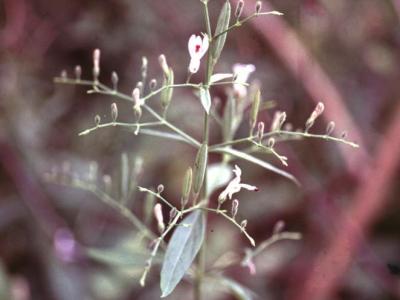(en territorios con usos significativos TRAMIL)
Jamaica:
- rice bitters
partes aéreas o planta entera, fresca o seca, decocción, vía oral1
*depurativo: tomado como medida profiláctica para mantener la salud mejorando la desintoxicación y ayudando a reducir la acumulación de productos metabólicos de desecho en el cuerpo. Algunos encuestados afirman que la "limpieza" de la sangre resuelve cualquier problema de piel1.
De acuerdo con la información disponible:
El uso de las partes aéreas o la planta entera en decocción por vía oral como depurativo, se clasifica como REC con base en el empleo significativo tradicional documentado en las encuestas TRAMIL, los estudios de toxicidad y la información científica publicada.
No usar durante el embarazo, la lactancia2,3 ni en niños menores de 12 años.
Para el “blood cleanse” (depurativo):
preparar una decocción con 3 gramos de las partes aéreas o de la planta entera en 1 taza de agua (250 mililitros), hervir 10 minutos en recipiente tapado. Dejar enfriar, colar (filtrar) y beber 2 tazas al día.
Ninguna preparación debe guardarse por más de 24 horas, ni fuera de refrigeración.
1 PICKING D, MITCHELL S, DELGODA R, YOUNGER N, 2011
TRAMIL survey. Natural Products Institute, The Biotechnology Centre & Tropical Metabolic Research Institute, University of the West Indies, Mona, Jamaica.
2 BONE K, 1999
Clinical applications of Ayurvedic and Chinese Herbs. Queensland, Australia: Phytotherapy Press.
3 WHO, 2004
Herba Andrographidis. WHO monographs on selected medicinal plants, Vol 2. Geneva, Switzerland. p20.
4 SHARMA A, KRISHAN L, HANDA SS, 1992
Standardization of the Indian crude drug kalmegh by high pressure liquid chromatographic determination of andrographolide. Phytochem Anal 3:129-131.
5 WEIMING C, XIAOTIAN L, 1982
Deoxyandrographolide-19beta-D-glucoside from the leaves of Andrographis paniculata. Planta Med 45:245-246.
6 CHEM W, LIANG X, 1982
Deoxyandrographolide 19ß-D-glucoside from the leaves of A. paniculata. Planta Medica 15:245-246.
7 SIRIPONG P, KONGKATHIP B, PREECHANUKOOL K, PICHA P, TUNSUWAN K, TAYLOR WC, 1992
Cytotoxic diterpenoid constituents from Andrographis paniculata, Nees leaves, J Sci Soc Th 18:187-194.
8 KEEFE JH, GHEEWALA NM, O'KEEFE JO, 2008
Dietary strategies for improving post-prandial glucose, lipids, inflammation and cardiovascular health. J Am Coll Cardiol 51:249-255.
9 HONG YH, CHAO WW, CHEN ML, LIN BF, 2009
Ethyl acetate extracts of alfalfa (Medicago sativa L.) sprouts inhibit lipopolysaccharide induced inflammation in vitro and in vivo. J Biomed Sci 16:64-75.
10 CHANG HM, BUT PPH, 1986
Pharmacology and applications of Chinese materia medica. Vol. 1. Singapore, World Scientific 1:918-928.
11 MATSUDA T, KUROYANAGI M, SUGIYAMA S, 1994
Cell differentiation-inducing diterpenes from Andrographis paniculata Nees. Chem Pharm Bull (Tokyo) 42:1216-1225.
12 KOTESWARA RAO Y, VIMALAMMA G, RAO CV, TZENG YM, 2004
Flavonoids and andrographolides from Andrographis paniculata. Phytochemistry 65:2317-2321.
13 RAO YK, VIMALAMMA G, RAO CV, TZENG Y, 2004
Flavonoids and andrographolides from Andrographis paniculata. Phytochemistry 65:2317-2321.
14 RAO YK, VIMALAMMA G, RAO CV, TZENG Y, 2010
A new diterpene from the leaves of Andrographis paniculata Nees. Fitoterapia 81(6):610-613.
15 ZAIDAN MRS, NOOR RA, BADRUL AR, ADLIN A, NORAZAH A, ZAKIAH I, 2005
In vitro screening of five local medicinal plants for antibacterial activity using disc diffusion method. Tropical Biomedicine 22(2):165-170.
16 GEORGE M, PANDALAI KM, 1949
Investigations on plant antibiotics. Part IV. Further search for antibiotic substances in Indian medicinal plants. Indian J of Medical Research 37:169–181.
17 NAKANISHI K, SASAKI S, KIANG AK, GOH J, KAKISAWA H, OHASHI M, GOTO M, WATANABE J, YOKOTANI H, MATSUMURA C, TOGASHI M, 1965
Phytochemical survey of Malaysian plants: preliminary chemical and pharmacological screening. Chem Pharm Bull 13:882–890.
18 LEELARASAMEE A, TRAKULSOMBOON S, SITTISOMWONG N, 1990
Undetectable antibacterial activity of Andrographis paniculata (Burm) Wall. ex Nees. J of the Medical Association of Thailand 73(6):299–304.
19 CHATURVEDI GN, 1983
Clinical studies on kalmegh (Andrographis paniculata) in infectious hepatitis. J of the International Institute of Ayurveda 2:208–211.
20 PURI A, SAXENA R, SAXENA RP, SAXENA KC, SRIVASTAVA V, TANDON JS, 1993
Immunostimulant agents from Andrographis paniculata. J Nat Prod, 56(7):995–999.
21 JARUKAMJORN K, DON-IN K, MAKEJARUSKUL C, LAHA T, DAODEE S, PEARAKSA P, SRIPANIDKULCHAI BO, 2006
Impact of Andrographis paniculata crude extract on mouse hepatic cytochrome P450 enzymes. J Ethnopharmacol 105(3):464-467.
22 CHOUDHURY BR, PODDAR MK, 1984
Andrographolide and kalmegh (Andrographis paniculata) extract: in vivo and in vitro effect on hepatic lipid peroxidation. Methods Find Exp Clin Pharmacol 6(9):481-485.
23 MELCHIOR J, PALM S, WIKMAN G, 1996
Controlled clinical study of standardized Andrographis paniculata extract in common cold. Phytomedicine 3(4):315-318.
24 GABRIELIAN ES, SHUKARIAN AK, GOUKASOVA GI, CHANDANIAN GL, PANOSSIAN AG, WIKMAN G, WAGNER H, 2002
A double blind, placebo-controlled study of Andrographis paniculata fixed combination Kan Jang in the treatment of acute upper respiratory tract infections including sinusitis. Phytomedicine 9(7): 589–597.
25 CHANDER R, SRIVASTAVA V, TANDON JS, KAPOOR NK, 1995
Antihepatotoxic activity of diterpenes of Andrographis paniculata (kalmegh) against Plasmodium berghei-induced hepatic damage in Mastomys natalensis. Pharm Biol 33:135-138.
26 DHAMMAUPAKORN P, CHAICHANTIPYUTH C, 1989
Acute and subchronic toxicity studies of Andrographis paniculata in rats and mice. Abstr. the 8th Symp, Faculty of Pharmacy, Chulalongkorn University Bangkok, Thailand.
27 VEDAVATHY S, RAO KN, 1991
Antipyretic activity of six indigenous medicinal plants of Tirumala Hills, Andhra Pradesh, India. J Ethnopharmacol 33:193-196.
28 SITHISOMWONGSE N, PHENGCHATA J, CHEEWAPATANA S, 1989
Acute and chronic toxicity of Andrographis paniculata Nee. Th J Pharm Sci 14(2):109-117.
29 BURGOS RA, CABALLERO EE, SÁNCHEZ NS, SCHROEDER RA, WIKMAN GK, HANCKE JL, 1997
Testicular toxicity assesment of Andrographis paniculata dried extract in rats. J Ethnopharmacol 58:219-224.
30 MKRTCHYANA A, PANOSYANA V, PANOSSIANB A, WIKMANB G, WAGNERC H, 2005
A phase I clinical study of Andrographis paniculata fixed combination Kan JangTM versus ginseng and valerian on the semen quality of healthy male subjects. Phytomedicine 12:403–409.


